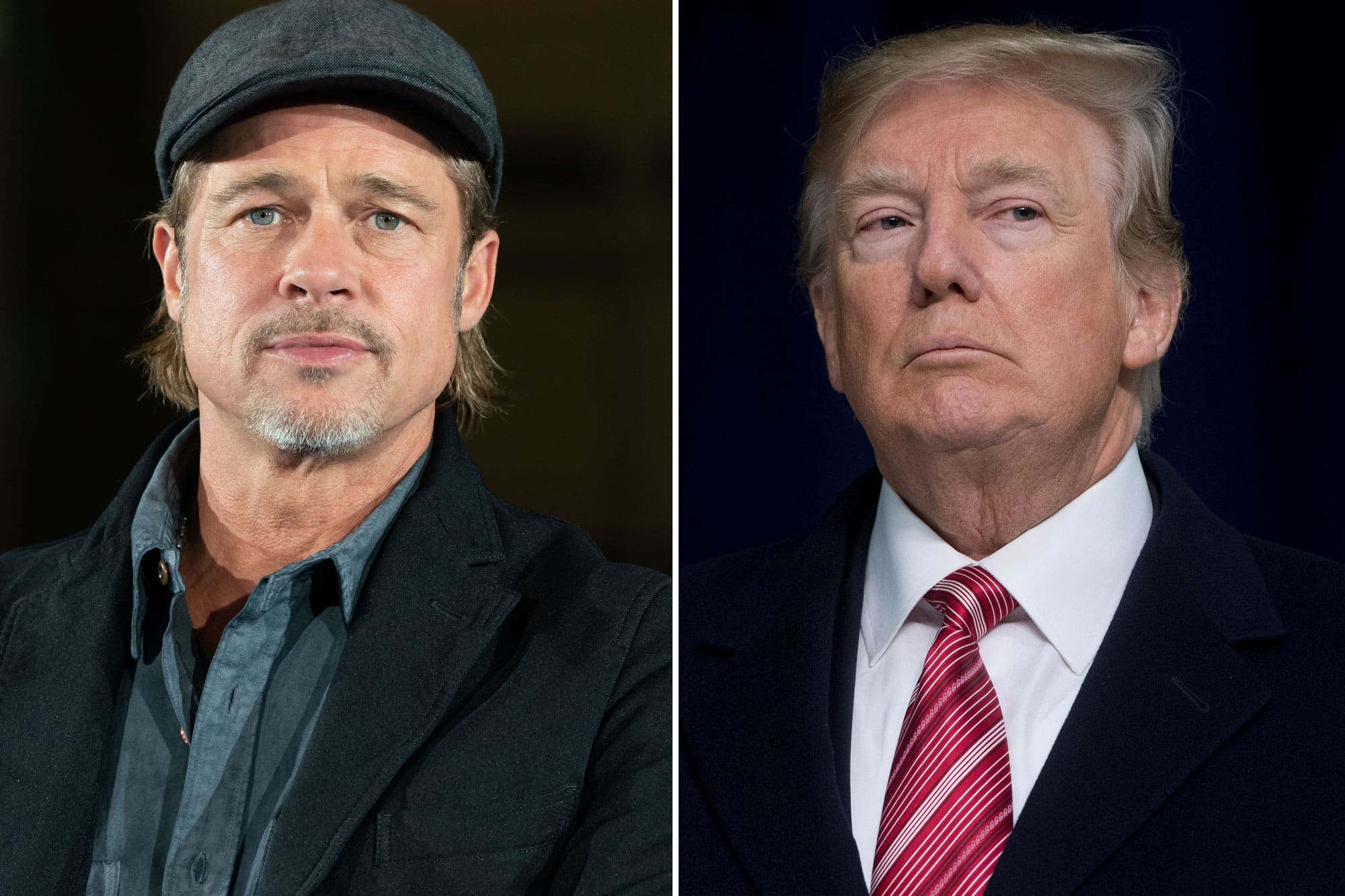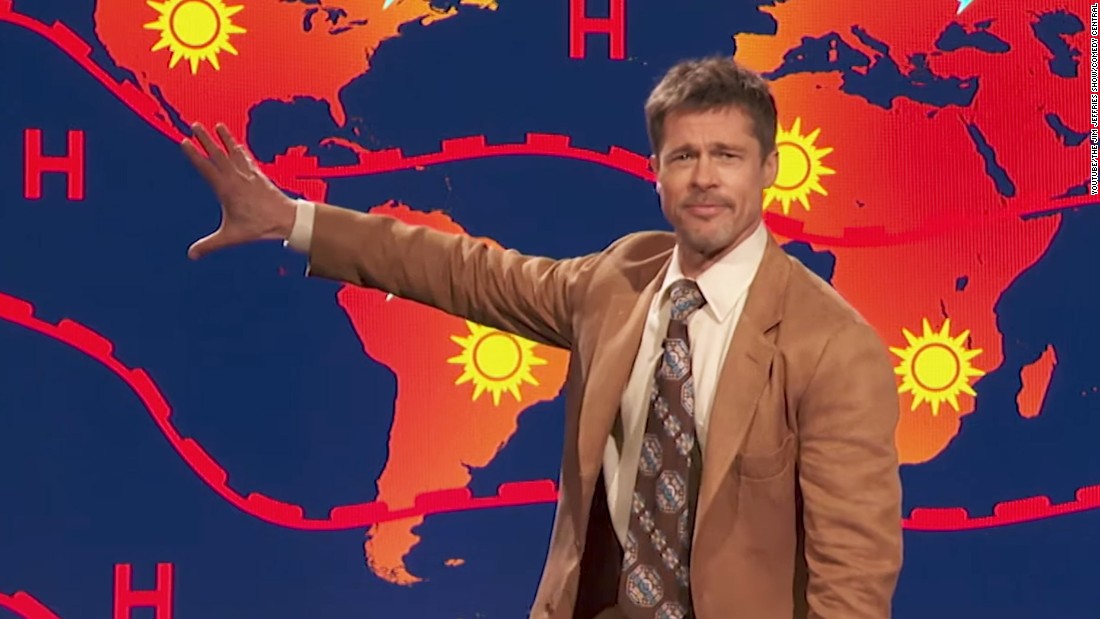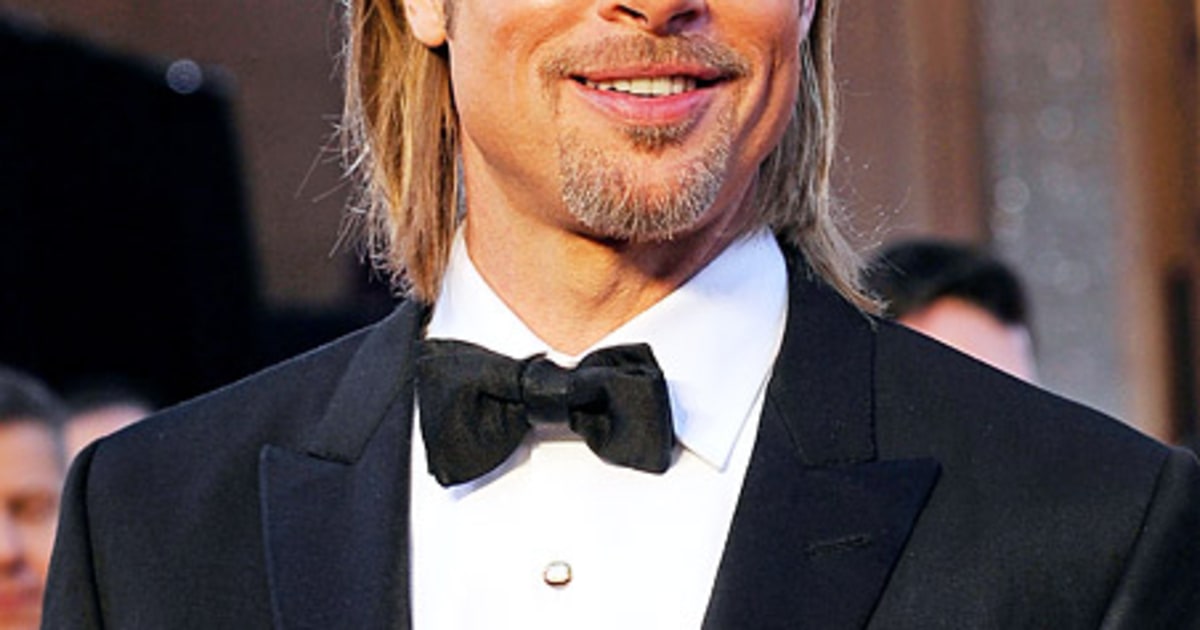Is the actor, Brad Pitt, a member of the Democratic Party? A definitive statement regarding political affiliation for this individual is elusive.
The term "Brad Pitt Democrat" lacks clear meaning in the context of political affiliation. While Brad Pitt has publically supported various causes aligned with progressive ideals, his specific political party registration or active participation in Democratic campaigns is not publicly documented. Therefore, the label "Brad Pitt Democrat" serves more as a colloquial description of associated views rather than a factual statement of party membership.
Public figures often express support for social programs, environmental protection, and other issues often associated with the Democratic Party. Determining whether this aligns with formal party membership is difficult without direct statements from the individual regarding their political affiliations.
| Category | Information |
|---|---|
| Name | William Bradley Pitt |
| Occupation | Actor, Producer |
| Known for | Numerous film roles, philanthropic endeavors |
| Political Activism | Public support for various progressive causes |
Further exploration of Brad Pitt's public statements and endorsements is necessary to understand his political views. This examination would move beyond a simple label like "Brad Pitt Democrat" to a more in-depth discussion of specific political positions and actions.
Brad Pitt Democrat
Examining the concept of "Brad Pitt Democrat" requires acknowledging the absence of explicit political party affiliation. This exploration focuses on aspects related to the term's implications, rather than definitive declarations.
- Public image
- Philanthropic work
- Associated causes
- Political stances
- Media portrayals
- Public perception
The term "Brad Pitt Democrat" is more suggestive than definitive. Public perception often links actors' public image with particular political leanings. Brad Pitt's philanthropic activities, support for environmental causes, and occasional statements on social issues are often interpreted within a progressive framework. The media's portrayal of celebrities, often emphasizing their public stances, contributes to this perception. Understanding the interconnectedness of public image, philanthropic activities, and perceived political positions is critical when evaluating such labels. Thus, the label, while not definitive, highlights the complex interplay between public figures, their actions, and societal interpretations.
1. Public Image
Public image plays a significant role in shaping perceptions of individuals, including actors. A public persona often associated with progressive causes can contribute to the perception of an individual as holding similar political views. This association, though not a definitive statement of political affiliation, can influence public perception. For example, if an actor consistently supports environmental organizations or advocates for social justice issues, the public may perceive this actor as aligned with progressive ideologies.
The connection between public image and the perception of political affiliation is multifaceted. It's influenced by the actor's chosen roles, public statements, and endorsements. For example, if an actor publicly supports a political candidate or cause, the media often reports this, which further reinforces the association in public perception. This association isn't a direct cause-and-effect relationship; however, the consistent presentation of certain values or positions can powerfully shape public understanding of a celebrity's potential political leanings. The perceived alignment with particular political ideals, derived from their public image, can be a potent factor in shaping opinions about individuals, even if no formal political affiliation is explicitly stated. This perception, in turn, can impact how individuals are viewed and engaged with within a political context.
In conclusion, public image is a crucial component in forming public perceptions about political alignment. The consistent presentation of values and positions, through various means like endorsements or publicized support for specific causes, can create a link in the public mind between a celebrity's image and political leanings. While this association isn't definitive proof of political affiliation, it demonstrably influences how the public perceives and interacts with individuals in the public eye. Understanding this connection is crucial for analyzing and interpreting public discourse surrounding public figures and their perceived political stances.
2. Philanthropic Work
The connection between philanthropic work and perceived political leanings, exemplified in the case of "Brad Pitt Democrat," is indirect yet significant. Philanthropic activities, particularly those focused on social causes, can often be interpreted as aligning with specific political ideologies. Examining this connection provides insight into how public perception interprets actions within a broader political context.
- Alignment with Progressive Values
Many philanthropic endeavors, particularly those focusing on issues such as poverty alleviation, environmental protection, or humanitarian aid, are frequently associated with progressive political values. If an individual's philanthropic efforts align with these causes, the public might interpret this as supporting policies frequently associated with the Democratic Party. This connection is often made through a common thread of social responsibility and concern for disadvantaged groups.
- Lack of Direct Correlation
It's essential to recognize that philanthropic work does not inherently equate to political affiliation. An individual might support multiple causes, including those that aren't overtly linked to one specific political party. A person's philanthropic choices, while often interpreted within a political framework, can originate from a variety of motivations, such as personal values, faith, or a desire to improve societal conditions. The decision to engage in philanthropy is multifaceted and complex.
- Influence of Public Perception
The media and public often scrutinize the philanthropic activities of public figures like Brad Pitt, often drawing inferences about possible political leanings. This interpretation, however, must be approached with caution. Direct statements regarding political affiliations are essential to avoid misinterpreting altruistic actions as formal party endorsements.
- Examples in Action
Observing the specific charities or causes supported offers a more nuanced perspective. If Brad Pitt's philanthropy is primarily focused on humanitarian assistance or environmental preservation, this might be seen as supporting principles often emphasized in progressive political discourse. Conversely, support for causes unrelated to social or economic issues might not align with a specific political ideology.
In summary, while philanthropic efforts can be interpreted within a political framework, especially in the case of public figures, a definitive connection between philanthropic work and political affiliation is often absent. The public's perception plays a significant role in shaping these interpretations, but scrutiny of specific causes and motivations is crucial for a thorough understanding. Examining the specific causes supported, rather than relying solely on perceived alignments, is a more robust approach to comprehending the relationship between philanthropy and political perception.
3. Associated Causes
The connection between "associated causes" and the notion of "Brad Pitt Democrat" hinges on the interpretation of public endorsements and support for certain social and environmental initiatives. Analyzing these associated causes allows for a more nuanced understanding of potential political leanings, without definitively establishing political affiliation.
Public figures often support causes aligned with particular ideologies. If Brad Pitt consistently champions environmental protection or social justice initiatives, the public frequently interprets these actions as reflecting progressive values, potentially aligning with the Democratic Party. However, it's crucial to recognize that supporting these causes may stem from personal values rather than a formal political stance. A thorough analysis requires examining the specific causes, their context, and Brad Pitt's individual motivations, rather than relying solely on broad associations.
For example, if Brad Pitt were to publicly support organizations working to combat climate change or advocating for affordable housing, these actions would likely be perceived as aligned with Democratic Party platforms. Conversely, support for causes unconnected to traditional Democratic values, like a local arts organization, wouldn't necessarily reflect a political alignment. The critical factor is the alignment between the cause and the individual's reported values. This necessitates a detailed examination of specific instances rather than generalizing from broad associations. This careful consideration is vital, especially when dealing with the complex interplay of public image and political interpretation.
In summary, analyzing associated causes provides insights into potential political leanings. However, this analysis is indirect and requires considering the nature of the causes, their connection to political ideologies, and the individual's motivations behind supporting them. A complete understanding necessitates careful examination of specific actions and motivations, rather than relying on generalized interpretations of associated causes. Without explicit statements of political affiliation, the connection between associated causes and political leanings remains a matter of interpretation.
4. Political Stances
The concept of "Brad Pitt Democrat" relies heavily on perceived political stances. A public figure's demonstrable alignment with specific political viewpoints, even if not explicitly stated party affiliations, creates a linkage in public perception. However, direct evidence of formal political endorsements or declarations of party affiliation is lacking in the case of Brad Pitt. Consequently, assessing political stances becomes crucial for understanding the basis of the "Brad Pitt Democrat" label.
Examining publicly available information, including statements, endorsements, and philanthropic activities, is necessary to understand potential political stances. If Brad Pitt publicly supports organizations advocating for social justice issues or environmental protection, observers may infer that these actions correlate with a progressive political outlook. Conversely, support for organizations with differing political agendas would offer a contrasting perspective. Crucially, the absence of explicit political statements makes discerning genuine political stances challenging. Interpreting the totality of available data is paramount.
The importance of political stances lies in their ability to shape public perception. Public perception is a complex interplay of various factors, including media representation, public statements, and philanthropic activities. While political stances are often interpreted through a lens of perceived alignment with specific parties, this association is not inherently definitive. Without direct political declarations, inferences about political leanings remain tentative. The absence of formal political stances, or endorsements, signifies a gap in information that impacts analysis, emphasizing the importance of interpreting available evidence cautiously. A robust understanding of political stances requires a comprehensive review of public statements, media reports, and endorsements rather than relying solely on speculation.
5. Media Portrayals
Media portrayals significantly influence the perception of public figures, including actors. In the context of "Brad Pitt Democrat," media coverage often contributes to the public's understanding of his political leanings. The manner in which the media presents an individual's actions, statements, and associations shapes public opinion. If media outlets consistently portray Brad Pitt as supporting progressive causes, this reinforces the association in the public's mind. Conversely, if the media primarily focuses on other aspects of his life, it might diminish this perceived connection.
Specific examples illustrate this connection. Suppose the media extensively reports on Brad Pitt's donations to environmental organizations. Such coverage can create a narrative associating him with environmentally conscious causes, often linked to Democratic platforms. Conversely, if the media highlights Brad Pitt's involvement in projects with no explicit political or social message, this may not enhance or diminish the "Brad Pitt Democrat" label. Media attention is crucial to shaping this interpretation. The tone and focus of the reporting directly impact public perception; a positive narrative connected to progressive causes reinforces the association, while neutral coverage has less impact.
Recognizing the media's influence on public perception of political stances is crucial. Without careful analysis, media portrayals can create inaccuracies or misinterpretations about public figures. Media choices, be it selective reporting, framing narratives, or particular angles, contribute to public understanding of individuals' perceived political inclinations. Therefore, analyzing media portrayals is an essential component in understanding how public perception of political positions develops, particularly regarding figures like Brad Pitt where no explicit political statements exist.
6. Public Perception
Public perception plays a crucial role in shaping understanding of public figures like Brad Pitt. The label "Brad Pitt Democrat" exists primarily within the realm of public perception, not as a formal declaration. This perception emerges from various sources, including media portrayals, philanthropic activities, and perceived alignment with progressive social causes. Consequently, public perception acts as a significant factor in shaping the narrative surrounding Brad Pitt's potential political leanings.
Public perception is a complex phenomenon, influenced by a multitude of factors. Media coverage, particularly news reporting and commentary on social media, often plays a pivotal role in shaping opinions. If Brad Pitt consistently supports organizations or causes associated with the Democratic Party, media often highlights this, thus contributing to a public perception of alignment. Conversely, if media attention centers on other aspects of his life, public perception of political leanings may diminish. Furthermore, public perception can be swayed by individuals' personal values and interpretations. An individual might perceive an action, such as a donation to an environmental charity, as a sign of progressive political views. Therefore, the perception is subjective and not solely derived from objective facts.
Understanding the importance of public perception regarding "Brad Pitt Democrat" is crucial for several reasons. For example, it informs public discourse and influences political discussions. The perception of celebrity political endorsements, even if lacking formal affiliations, impacts voter behavior and public opinions. Public perception can significantly influence how a public figure is viewed, impacting their career trajectory and, potentially, broader societal values. Analysis of the causal factors behind this perception is crucial to fully grasp how interpretations affect public understanding of a public figure. Furthermore, this understanding underlines the importance of responsible media reporting, given the influence it has on public perceptions of political stances of public figures, without resorting to definitive statements or formal labels.
Frequently Asked Questions About Brad Pitt and Political Affiliation
This section addresses common questions and concerns regarding Brad Pitt's political leanings, focusing on accurate information and avoiding speculation.
Question 1: Is Brad Pitt a Democrat?
A definitive answer regarding Brad Pitt's party affiliation is unavailable. Public statements and actions do not explicitly indicate party membership. While observed support for specific causes aligns with certain political ideologies, these do not constitute a formal declaration of party affiliation.
Question 2: How do Brad Pitt's philanthropic endeavors relate to political affiliation?
Brad Pitt's support for various causes, particularly those aligned with social and environmental issues, is often linked to progressive political ideals. However, philanthropic activities do not inherently equate to party membership. Supporting social causes is a complex personal decision motivated by diverse factors beyond formal political positions.
Question 3: How do media portrayals affect public perception of Brad Pitt's political views?
Media coverage significantly shapes public perception. Frequent reporting on Brad Pitt's support for organizations linked to progressive causes may create an association with a particular political viewpoint. However, media portrayals do not equate to definitive political statements.
Question 4: Can Brad Pitt's public image be interpreted as a political statement?
Brad Pitt's public image, including his actions and endorsements, may be interpreted by the public as reflecting political leanings. This interpretation, however, lacks formal confirmation. Public image is a complex amalgamation of various factors and does not automatically translate to a formal political stance.
Question 5: What is the significance of the term "Brad Pitt Democrat"?
The term "Brad Pitt Democrat" arises from public perception rather than formal declaration. It reflects the association of certain actions and support for progressive causes with Democratic Party ideals, but does not represent a definitive political affiliation.
In summary, while public perception often links Brad Pitt with progressive ideals due to his philanthropic efforts and reported support for certain causes, these associations are not definitive proof of political party affiliation. Direct declarations or statements from the individual regarding political party membership are absent. Public figures often engage in charitable work and support various causes without adhering to a specific political party.
Moving forward, examining specific instances and motivations rather than relying on broad labels or generalizations will offer more accurate perspectives on the relationship between public figures and political ideologies.
Conclusion Regarding "Brad Pitt Democrat"
The term "Brad Pitt Democrat" represents a public perception, not a formal political declaration. Analysis reveals that while Brad Pitt's philanthropic activities and public expressions align with progressive causes, a definitive statement of political affiliation remains elusive. Public image, media portrayals, and associated causes significantly influence the perception of his potential political leanings, but these do not constitute formal party membership. The absence of explicit political endorsements or statements underscores the crucial distinction between observed actions and declarations of political affiliation.
The exploration of this concept highlights the complexities of interpreting public figures' actions within a political framework. Examining specific actions, motivations, and contextual factors rather than relying on broad labels is crucial for a nuanced understanding. Further, responsible media reporting and public analysis should avoid making definitive statements about political affiliations based solely on indirect associations. Understanding the intricacies of public perception and its influence on the interpretation of public figures' actions is essential for informed discourse on political matters and maintaining a clear separation between public image and formal political positions.
Article Recommendations



ncG1vNJzZmibkafBprjMmqmknaSeu6h6zqueaJmTqb%2Bmv9KeqmavmKR6pbHFoqWenF%2BXv6KwjKmgraxdmbKuu8KrmK1mmKm6rQ%3D%3D